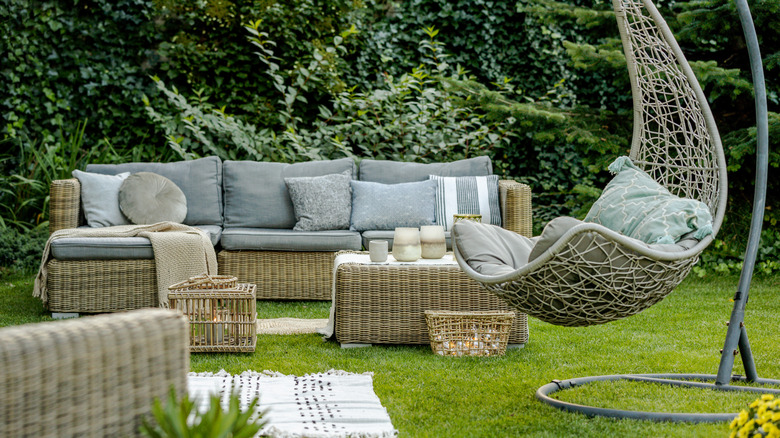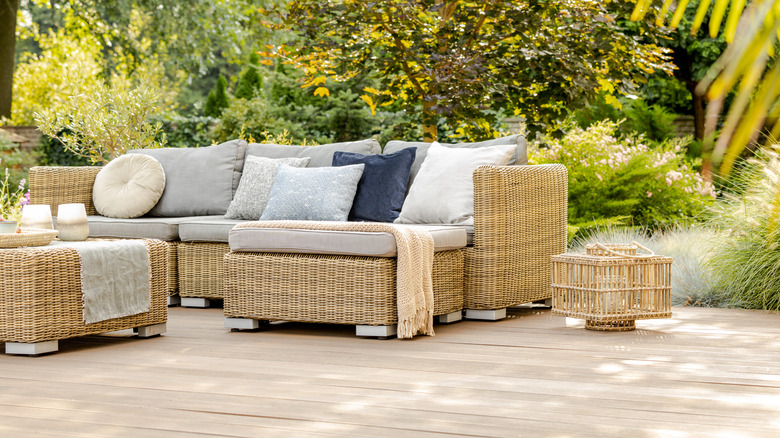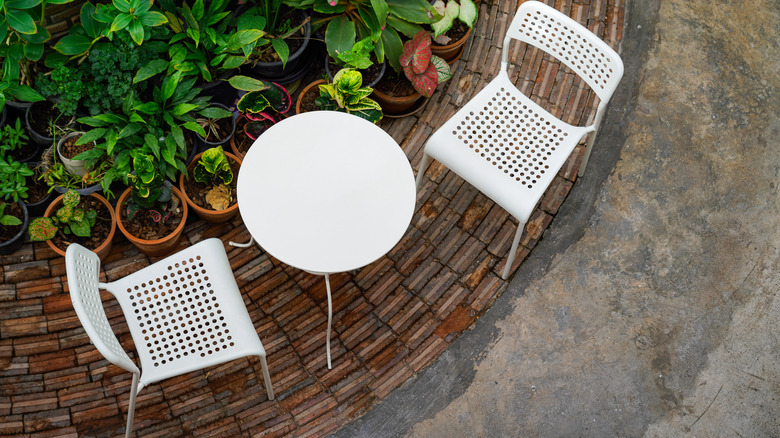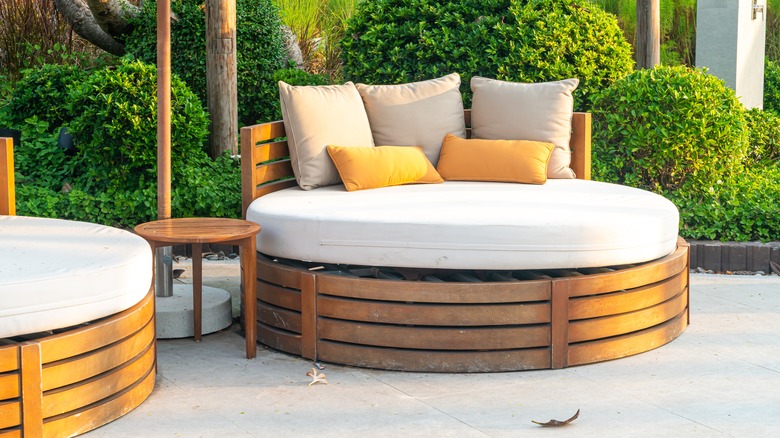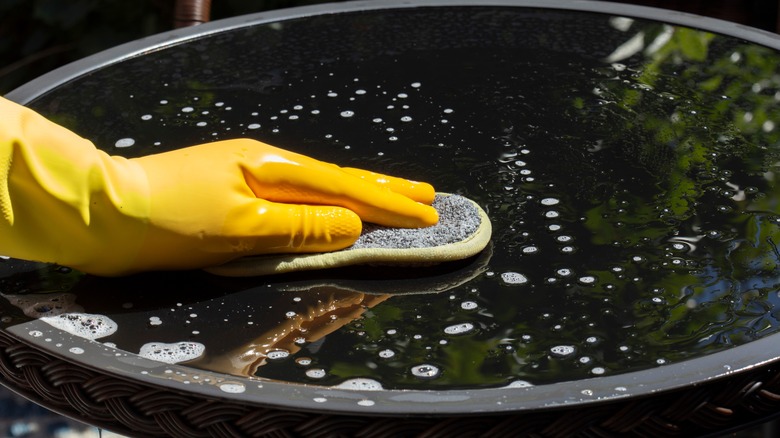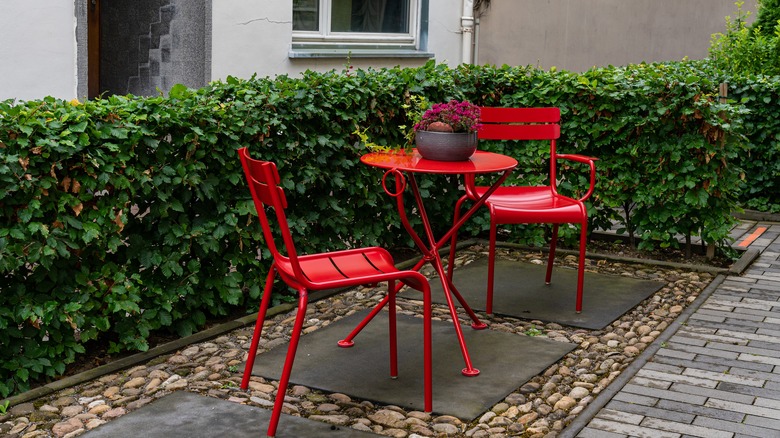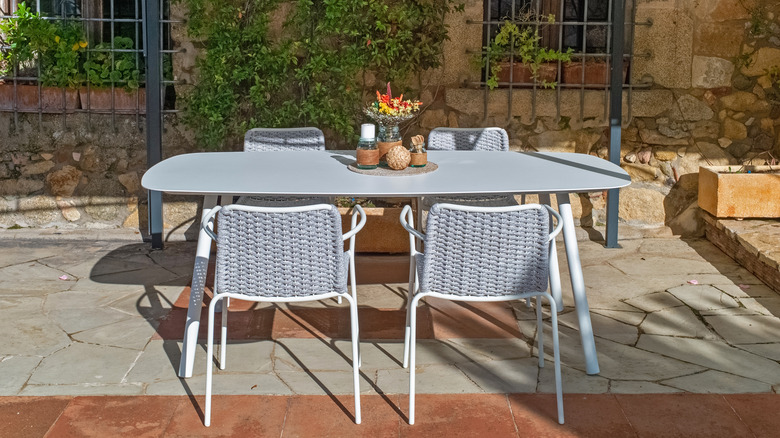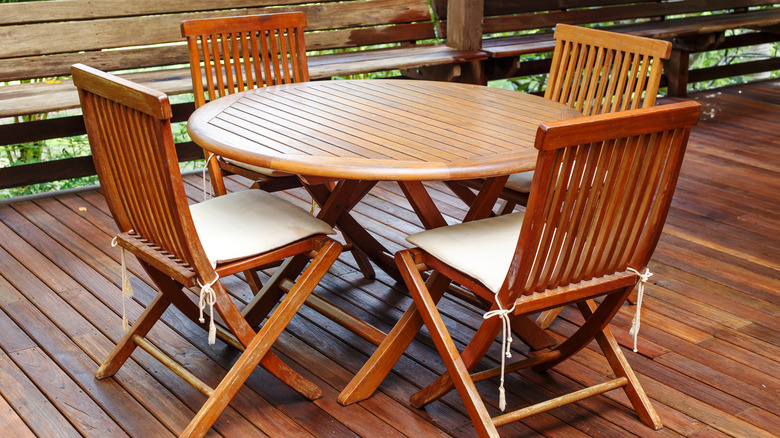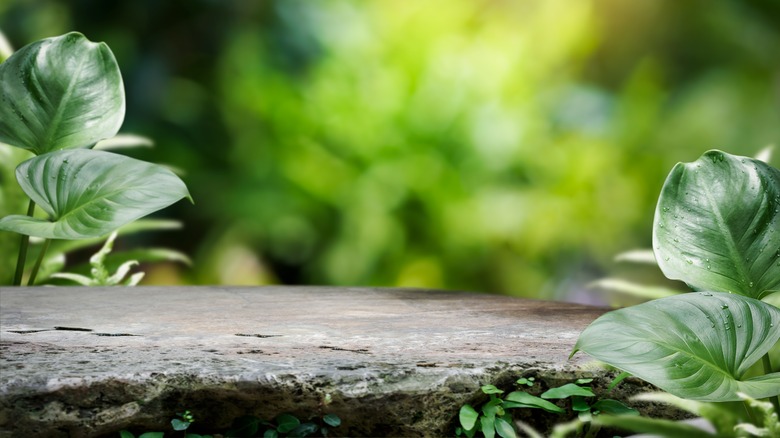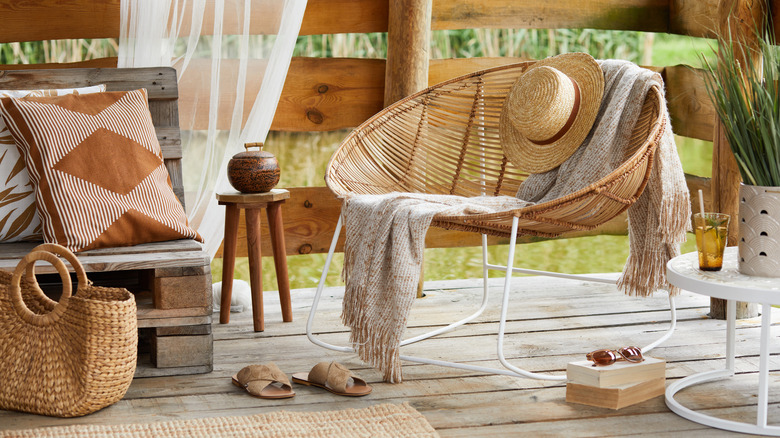How To Clean Your Outdoor Furniture
Whether dealing with wrought iron, wicker, or even plastic pieces, your outdoor furniture requires a fair bit of attention as it is exposed to the elements. From the high heat of the summer months through to the unforgiving cold and dryness of the winter, taking care of your outdoor furniture means you get the best use out of it for a longer period of time. However, proper cleaning can require more than just getting a dust cloth and wiping your pieces down.
Depending on your furniture sets, specific cleaning methods will benefit them and ensure they last longer. For example, iron, steel, and metal furniture are vulnerable to rust, so your cleaning and storage methods must prioritize protection against that threat. Excess moisture on your wooden furniture can be detrimental to your beautiful tables and chairs, so you shouldn't soak them with cleaning products. Not sure where to get started? Here is your ultimate cheat sheet on how to clean outdoor patio furniture.
Vacuum, spot clean, or wash wicker furniture
Wicker is lauded as a low-maintenance material, and rightfully so. It doesn't require much care to keep clean, and if properly taken care of, it can last years without replacement. So although a proper cleaning doesn't need much more than the items you already have in the pantry, it is important to ensure you clean your wicker furniture thoroughly to avoid any damage. For starters, use a vacuum cleaner with a brush attachment to remove dust particles from the surface and harder-to-reach areas.
After you dust the wicker, you can focus on spot treatment — cleaning specific stains on the item without cleaning the entire thing. To spot-treat your furniture, mix detergent or dishwasher soap with warm water. After that, take a small brush — an old toothbrush will do — or a hard sponge. Avoid drenching the wicker in water while cleaning, as this can lead to mold and mildew, which we do not want. Dip the brush into the solution and scrub away at the stain. Always let your wicker dry completely before storing it or placing other items on it.
Use bleach or vinegar for your white plastic chairs
Plastic is another relatively low-maintenance material, but diligent cleaning will help keep your pieces pristine, as most white furniture items tend to be vulnerable to discoloration and staining. Due to its affordability, it's often easy to pay little attention to plastic furniture. This can lead to all sorts of stains becoming more challenging to remove. When left outside without covering, white plastic pieces become exposed to sun damage, bird droppings, and more. The key to keeping your plastic furniture sparkling white is to prevent any stains or discoloration from taking hold.
Bleach and hot water have been the go-to combination for cleaning white products, and with good reason. Pour 1/4 cup of bleach into a bucket of hot water, grab a scrub brush, and dip it into the mix. Be sure to wear rubber gloves to avoid exposing your hands to the potent solution. Another trick to keep the shine on your white plastic furniture is to use vinegar since it's acidic. You'll also need a bucket of hot water and a soft brush. Starting with the most stubborn stains first, scrub the item as hard as needed. When done, hose your furniture down and let it air dry for a few hours. There are even more options for cleaning your plastic furniture, including baking soda and dishwasher soap — add water!
Read the washing guidelines on your fabrics
When it comes to the fabrics on your furniture, there may be specific cleaning instructions to follow. Before you begin the cleaning process for these items, be sure to read the washing guidelines to avoid damaging the fabric. If your patio cushions are exposed to the elements, including bird droppings, rain, and dust particles, throwing their slipcovers into the washing machine could be a viable way to remove the stains.
If your cushion has no specific instructions, a hand wash is a great way to remove the stains. One trick is mixing 1 teaspoon of dishwasher soap, 1 teaspoon of borax, and warm water in a spray bottle. Take the fabric off the cushion and spray it down with the solution. Let it sit for a few minutes, then rinse with a hose. Pay special attention to the stubborn stains, ensuring that you spray them down. Some cushion covers can handle a power wash. If you have a pressure wash, mix dishwasher soap or a mild detergent with cold or warm water and wash.
Be careful not to scratch your glass top tables
Cleaning glass requires a soft touch, and even softer cleaning products, as hard-surface wipes can scratch your furniture, affecting the aesthetic. Be sure only to use glass-friendly cleaners for your glass-top tables. Begin by wiping down the table with a soft, lint-free cloth or sponge to remove any specs of dust or loose dirt. Once you're done dusting, soak your sponge or soft cloth in a soap-and-water mix and wipe down thoroughly. When you are done, rinse the item and leave it to air dry or wipe it down with a dry cloth. For that extra sparkle, you can use vinegar on the glass. Wipe the vinegar with another dry cloth.
For tempered glass, also known as toughened glass, you can go in with a vinegar solution. Although tempered glass is a thicker kind of glass, it is still subject to scratching, so it's important to avoid harsh cleaning products as you would with thinner glass. There are different cleaning products to consider for your glass items, from vinegar-based products to alcohol solutions. As mentioned above, vinegar's acidity makes it a favorite for thoroughly removing dirt or difficult debris. Alcohol is just as good, with the bonus of a quick dry which leaves no streaks on the glass. Additionally, alcohol disinfects your glass tops, reducing bacteria transfer.
Make your own protective oil for your metal furniture
Though metal is a strong material, it scratches easily. Therefore, it is a good idea to treat it as a delicate item when cleaning, opting for non-abrasive cleaning products. Of course, rust is one of the biggest threats to your metal furniture. When cleaning your metal furniture items, be on the lookout for any signs of rust, especially in the joints of the item. Rust is a detrimental threat to metal. However, it can be prevented by adding a coat of paint over scratches. Simply polish the area with sandpaper and apply a coat of rust-proof paint to seal it.
Use mild soap and a soft sponge to clean any metal item. After this, a good oil or polish will help the furniture to maintain its luster and shine. One such oil can be made at home. Lemon oil is a great and affordable alternative that can be used in multiple ways. To make your lemon oil, peel the skin off four or five lemons and soak them in coconut oil. Bring a pot of water to boil, reducing the heat to low to avoid the oils evaporating. Place the bowl of lemon peels over the boiling water for 20 minutes, then carefully lift out of the pot and leave to cool for about three hours. Once done, you can rub it all over your metal table and chairs for the sheen.
Beware of calcium buildup on your aluminum furniture
Calcium buildup is one of the big things to look out for with aluminum furniture. High levels of calcium and magnesium in water cause limescale buildup on your furniture. To prevent this from happening, the fool-proof combination of dishwasher soap, warm water, and a soft sponge can help keep your furniture free of limescale. However, if you notice your furniture is becoming calcified — that is, limescale is building — use a mixture of vinegar and water and a sponge to treat the affected areas.
As with your metal furniture, always inspect for scratches, using a protective coat to seal affected areas as necessary. Another thing to note when cleaning your aluminum furniture is to ensure that your tables and chairs are adequately dried. Ensure you do not leave any part of your furniture item damp or soaked in water. You also want to double-check that your products aren't alkaline. Though they work great on steel, alkaline products can cause damage to aluminum furniture as they can scratch the surface of your item, leaving it vulnerable to further damage.
Teak is a low-maintenance wood
Teak wood is a species of hardwood identified by its golden brown color. It's often the preferred wood for furniture making as it is considered very durable and mold resistant. It is also relatively unaffected by even the most extreme weather. Teak is also an interesting material for your furniture as it ages. Its golden brown hue begins to fade around six months. At 24 months, the wood completely transforms into a grayish color. If the golden-brown hue is something you wish to maintain, then it's a great idea to keep your teak furniture in the shade when you can.
Teak is also relatively easy to clean. For the most part, all you need is a mix of mild soap and water and a soft brush. Add vinegar to take care of areas with more difficult-to-remove stains. Thanks to the teak's natural oils, dry rot isn't something you need to worry about with this hardwood. Be sure to avoid using teak oil on your furniture, as it can strip the hardwood of its own natural oils as it evaporates. Dust and wipe down your furniture in between deep cleans to keep dust and debris to a minimum.
Seal your stone table tops
On the more artistic side of outdoor furniture is the stone tabletop, which often boasts a variety of designs and mosaics. These tops are made of natural stones, often handcrafted by artisans, ensuring a unique design. Thanks to their origins, stone slabs are usually relatively easy to maintain. A rule of thumb with this, and pretty much every kind of outdoor furniture, is to wipe off any stains as they occur. Drinks such as red wine and orange juice can cause lasting damage to the stone because of their acidity, so these should be cleaned up as soon as any spillage occurs.
Cleaning your stone tabletop is as easy as mixing a mild soap with water and using a soft sponge to wipe. Avoid using soaps with acidity, as this can compromise the quality of your stone table. You should apply a stone surface sealer to your tabletop once a year to maintain your furniture's sheen.
Use a toothbrush to remove stubborn stains in rattan
Rattan and wicker are often mistaken for one another, but there are some vast differences between the two. Rattan is a material made out of a vine that grows hundreds of feet long. Wicker, on the other hand, refers to weaving various materials — including rattan, reeds, and bamboo — together to get the final product. To clean rattan, you'll need a toothbrush to get into the crevices. This is another item of furniture that only needs soapy water as your cleaning agent.
However, rather than dunking the sponge into the soapy water, scoop only the bubbles onto the sponge, avoiding the water. This way, you avoid drowning your furniture in too much water, which can damage it. When you are done wiping down the rattan, leave it to air dry before storing it or placing cushions back on the furniture. If you have had your rattan furniture for a long time, it will likely experience some splitting and dryness. You can revive your furniture by applying boiled linseed oil to it. Apply as much as the rattan will absorb with a paintbrush and wipe down any excess. Leave the furniture to dry and harden before using.
